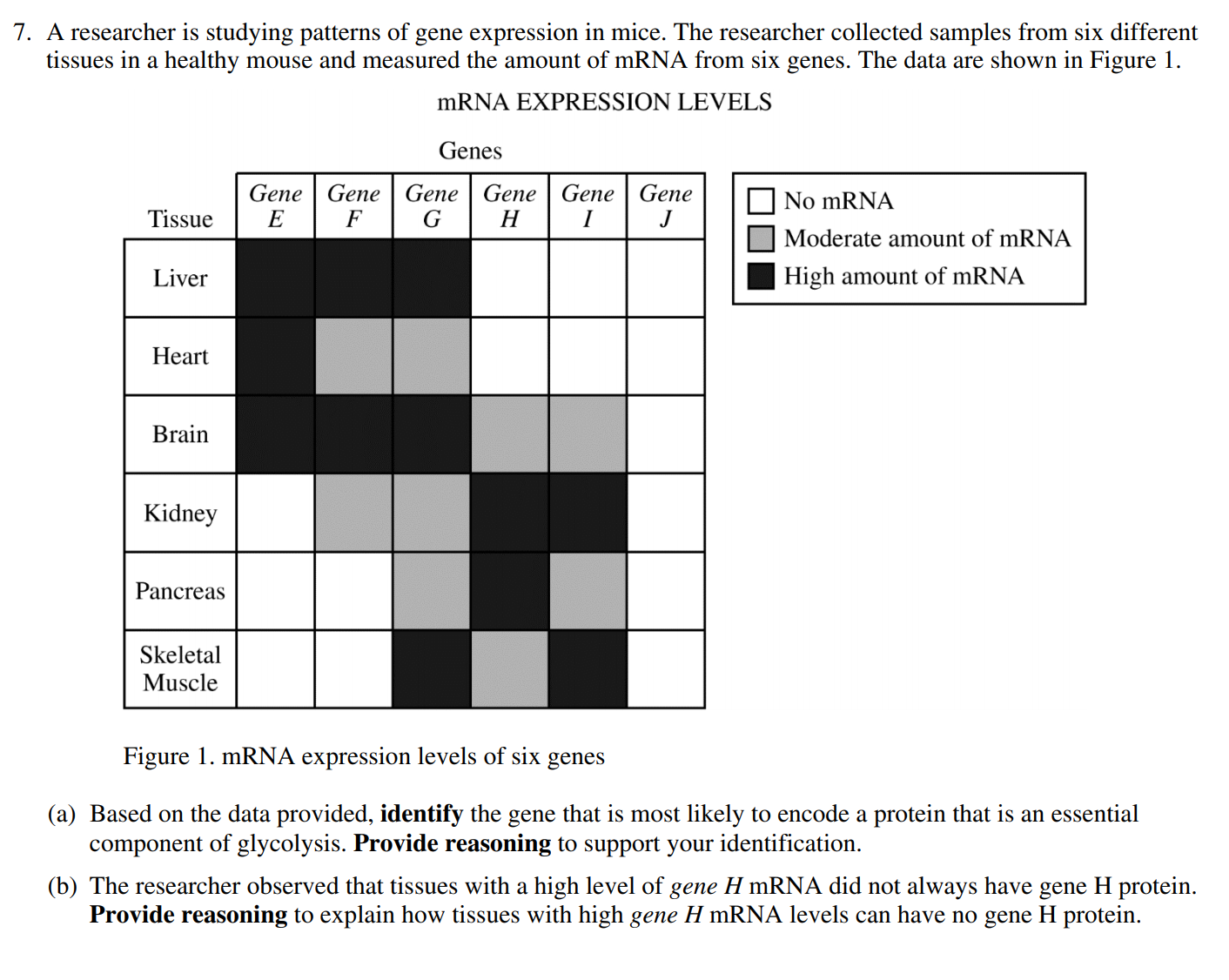Unit 6 FRQ (Genetic Expression) with Feedback
4 min read•june 18, 2024
Caroline Koffke
AP Biology 🧬
358 resourcesSee Units
View student writing samples for the 2019 AP Biology FRQ and corresponding feedback provided by Fiveable teacher Caroline Koffke. It is important to learn from how other students responded to improve one's own FRQ writing.
AP Bio Free Response Question for Genetic Expression

This question is from the 2019 AP Biology exam. All credit to College Board.
FRQ Student Answers and Feedback
FRQ Practice Submission 1
a) Gene G most likely encodes a protein essential to glycolysis. Glycolysis is a crucial part in cellular respiration (and is the first step), which provides ATP and energy for many functions to occur in our bodies. All of the tissues need to use energy and therefore require cellular respiration to provide the ATP it needs. Since only gene G is present in every tissue, it is most likely encoding the protein that the important process, glycolysis, needs.
b) Gene H could be more important to some tissues than others. The gene could still be transcribed by DNA polymerase and form pre-mRNA, but gene H may be removed during mRNA splicing if it is not needed, so there will be no gene H protein.
Teacher Feedback
Great work on your response. You received 2/2 points for part a by successfully identifying gene G and explaining your rationale behind your choice. You received 1/1 points for part b by explaining that gene H may be removed during RNA processing. GREAT work!
FRQ Practice Submission 2
a) The most likely gene to encode a protein that is an essential component of glycolysis is gene G. The reasoning is that it is the only Gene that is actively producing mRNA in all tissues.
b) Just because the gene is present does not mean it is being translated and transcribed. It is most likely methylated, or super coiled, and unable to be transcribed into a protein.
Teacher Feedback
You received 2/2 points for part a by identifying gene G and explaining your rational. You also received 1/1 points for part b by explaining the possible rationale for the presence of the gene without transcription and translation. Nice work!
FRQ Practice Submission 3
A. Gene G is most likely to encode a protein that is essential for glycolysis. The reason that it is gene g is that glycolysis an essential part of cellular respiration and is carried out in every type of cell. Gene G has to encode for a protein essential for glycolysis as in is the only gene produced in all cells.
B. The protein may not be important but the RNA polymerase may still create the mRNA. The H gene could be removed as an intron in post transcriptional modification where it would then broken down and sued to create more mRNA.
Teacher Feedback
You received 2/2 points for part a. You received 1/1 points for mentioning that gene H may be transcribed but removed as an intron.
FRQ Practice Submission 4
a) Gene G is most likely to encode a protein that is an essential component of glycolysis. Glycolysis is the first step in cellular respiration and is responsible for the breakdown of glucose into a more usable form by plants/animals, to which it converts it into ATP and two pyruvate molecules which later gets broken down into more energy for the cell. All cells require energy to survive as it is one of the main characteristics of living things. ATP is the energy that drives our bodies’ numerous metabolic processes, and so all of our tissues/organs require this energy in order to be able to perform their daily functions. Since all of the tissues contain gene G (presence in the mRNA), this indicates that it’s an important gene that is most likely responsible for encoding a protein responsible for cellular respiration in some way, shape, or form.
b) The lack of a gene H protein in the presence of a high gene mRNA level could indicate that the protein may be unessential or not needed in those tissues more so than others. What ends up happening is that the gene that codes for the H protein could still be transcribed by RNA polymerase and included in the premature mRNA, but it ends up being excised from the sequence as an intron, and would stay inside the nucleus, following post-transcriptional modifications such as mRNA splicing during the process of being transformed into a fully mature messenger RNA. Thus, since gene H stays inside the nucleus and does not travel to the ribosome in the cytoplasm, it does not get translated into a gene H protein.
Teacher Feedback
You received 2/2 points for your response to part A. You received 1/1 points for your response to part B. I am thoroughly impressed by the quality of information that you have included. Great work!
FRQ Practice Submission 5
a) Gene G most likely codes for glycolysis. All of the cells exhibit this gene as shown in the chart. Because glycolysis is essential in all cells, this suggests that this is the gene that codes for glycolysis.
b) Gene H was most likely an intron that got removed during RNA splicing. This gene may have coded for an RNA segment that was removed as it underwent modifications. Because introns are removed during RNA splicing, it can be stated that Gene H was removed during splicing, assuming that Gene H was an intron.
Teacher Feedback
You received 3/3 points for your response. Great use of vocabulary!
Browse Study Guides By Unit
🧪Unit 1 – Chemistry of Life
🧬Unit 2 – Cell Structure & Function
🔋Unit 3 – Cellular Energetics
🦠Unit 4 – Cell Communication & Cell Cycle
👪Unit 5 – Heredity
👻Unit 6 – Gene Expression & Regulation
🦍Unit 7 – Natural Selection
🌲Unit 8 – Ecology
📚Study Tools
🧐Exam Skills

Fiveable
Resources
© 2025 Fiveable Inc. All rights reserved.